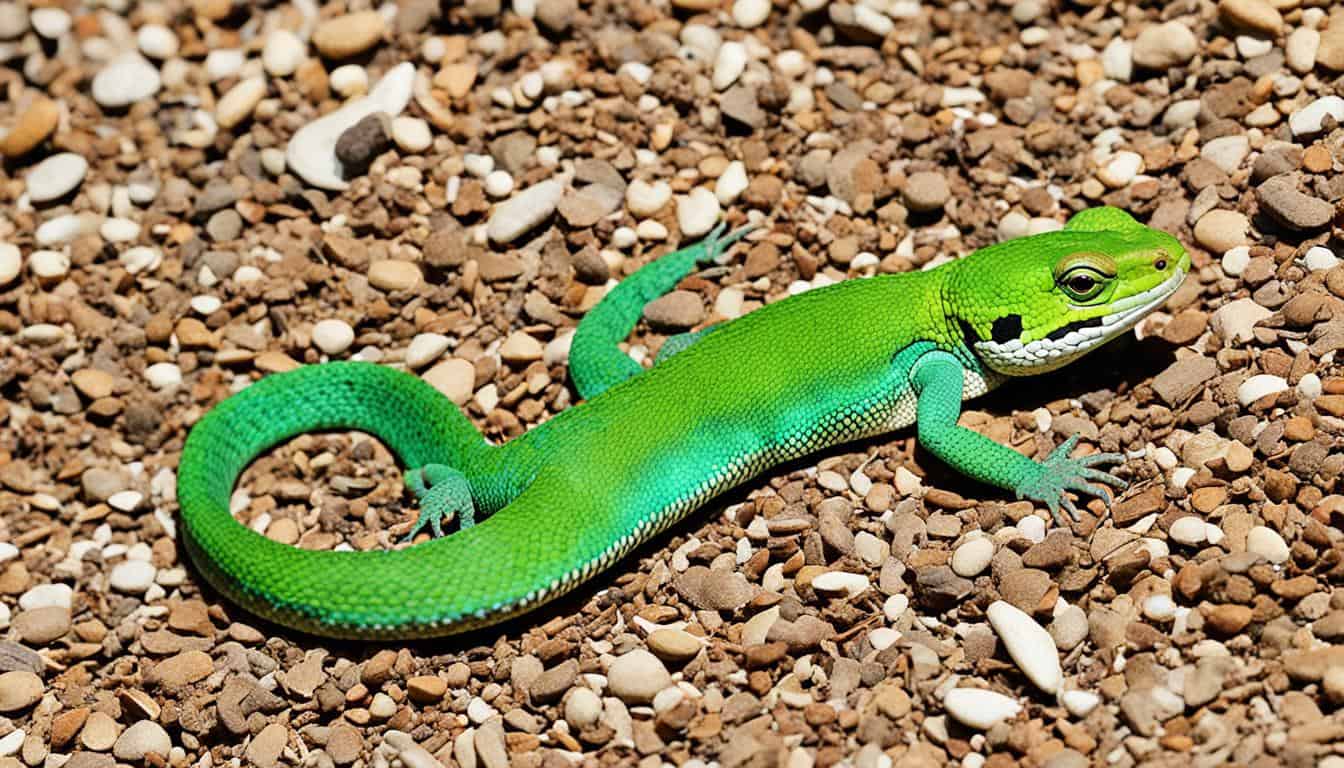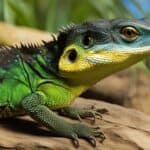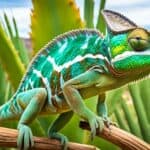Ever thought about the reptiles that live in the USA’s different areas? You have everything from the powerful American alligator in the South’s swamps to the Mojave Desert tortoise. These reptiles help make the USA a place full of amazing natural life. Let’s look at some of the most common reptiles in the country. We’ll learn about what makes them special and why they are so important for their homes.
The reptiles in the USA come in all shapes and sizes, just like the places they live. Some, like the Carolina Anole, can change color. Others, like the American alligator, are at the top of the food chain. This mix shows us how rich and varied the country’s wildlife is. It also reminds us why these reptiles are crucial to the ecosystems they live in.
American Alligator
The American Alligator, known as Alligator mississippiensis, is a top predator in the USA. It lives in the southeast, in places like Florida and Georgia. This special animal thrives in different freshwater areas, showing how diverse and important it is to the region.
Scientific Name: Alligator mississippiensis
Its scientific name is Alligator mississippiensis. By using this name, we show how Alligators stand out in the world of American reptiles. It highlights their unique biological features and genetics.
Habitat and Distribution
The Alligator lives in places like marshes and rivers. Its home includes several states, with Florida and Louisiana being key. The gator’s ability to live in different water areas shows its adaptability and adds to the variety of reptiles in the US.
Physical Characteristics
The American Alligator is dark and has a tough, short snout. These features help it hide and show its power in the reptile world. They are known for their strong presence and hunting skills among American reptiles.
Diet and Behavior
Alligators eat various things like fish, birds, and even other reptiles. This eating habit makes them key in keeping nature in balance as top predators. How they hunt and interact with others tells us a lot about the interesting world of American alligators.
Alligator Snapping Turtle
The Alligator Snapping Turtle goes by the scientific name Macrochelys temminckii. It is the largest freshwater turtle species in the world. This makes it a key member of North America’s reptile community.
Scientific Name: Macrochelys temminckii
Known for their unique look, snapping turtles are easy to spot. They mainly live in the southeastern USA’s slow waters. There, they find their perfect spot to live.
Habitat and Distribution
These turtles call slow rivers, lakes, and swamps home. They like places where they won’t be bothered. Sadly, they face threats like losing their homes. So, they are an important species to protect.
Physical Characteristics
The Alligator Snapping Turtle has a shell that feels like an alligator’s skin. Their jaws are strong and can hurt if they bite you. But, the strangest part is their tongue. It looks like a worm and helps them catch fish.
Interesting Facts
This turtle has special skills that make it a great hunter. Its worm-shaped tongue tricks fish so it can eat them. This makes the turtle very fascinating to nature lovers.
| Feature | Description |
|---|---|
| Scientific Name | Macrochelys temminckii |
| Habitat | Slow-moving freshwater bodies in the southeastern USA |
| Physical Characteristics | Ridged shell, powerful jaws, worm-like tongue |
| Conservation Status | Vulnerable |
The Alligator Snapping Turtle is a highlight in the US reptile world. Protecting them is critical. This ensures they will continue to be enjoyed by people in the future.
Carolina Anole
The Carolina Anole, known as Anolis carolinensis, is a unique lizard from the southeastern USA. It’s often called the American chameleon. This is because it can change its color like a chameleon. It’s a great example of how reptiles can adapt to different places.
Scientific Name: Anolis carolinensis
Carolina Anoles are known for their ability to live in many different places. They can be in dense forests or even in the city. They love to live in trees and can climb walls and fences easily.
Habitat and Distribution
These lizards are found in a wide range of environments in the southeastern USA. They like places with a lot of plants and things to climb. This shows how much they prefer living high up and in warm places.
Physical Characteristics
The Carolina Anole is a small lizard, about 5-8 inches long. It has a thin body, a long head, and tail. Their toes have special pads that help them climb. This lets them live in many different places.
Color Change Ability
What’s really cool about the Carolina Anole is its color-changing ability. It can go from bright green to brown. This change helps it hide or control its temperature. So, it can fit in and stay safe in many places.
This ability makes the Carolina Anole really good at surviving. It can hide from danger and stay comfortable by changing its color.
What are the most common reptiles found in the USA?
Looking closely at reptile life in the United States is like exploring a different world. In this world, every species is important for the environment. There are more than just alligators and turtles. We also find various snakes, friendly anoles, and big tortoises. These animals are interesting by themselves and show us how healthy the environment is. By knowing these common American reptiles, we learn more about the country’s nature.
It’s crucial to protect reptiles. They’re vital for the environment by balancing their homes. Knowing how to identify them helps with protection actions. This makes sure they continue to keep our ecosystems healthy. *Understanding the USA common reptiles overview* makes us value their importance more. It also shows why protecting them matters.
Now, let’s look at some well-known reptiles in the USA and why they matter:
| Reptile | Habitat | Ecological Role |
|---|---|---|
| American Alligator | Freshwater marshes, swamps, rivers, and lakes | Apex predator, maintains ecosystem balance |
| Alligator Snapping Turtle | Slow-moving freshwater bodies | Carnivorous scavenger, controls fish population |
| Carolina Anole | Urban and natural settings, arboreal habitats | Insect control, prey for larger predators |
| Common Garter Snake | Varied environments including wetlands and gardens | Pest control, prey for birds and mammals |
| Mojave Desert Tortoise | Desert ecosystems | Herbivory, soil aeration through burrowing |
These creatures show how diverse and important USA reptiles are. We must understand and protect their roles for our ecosystems to thrive. Actively support their conservation for a healthier American nature legacy.
Common Box Turtle
The Common Box Turtle, or Terrapene carolina, is a unique type of land turtle. It lives in the eastern part of the United States. These turtles are known for their special looks and how well they fit into their environment.
Scientific Name: Terrapene carolina
Known in science as Terrapene carolina, this turtle plays a big part in keeping its home healthy. It knows how to live in different places. This helps keep various natural areas balanced.
Habitat and Distribution
Box Turtles can be found in many places, from woodlands to your backyard. They are spread all over the eastern U.S. Their ability to live in different spots helps keep their homes safe.
Physical Characteristics
With its round, high shell and a moveable bottom, the Common Box Turtle is safe from many dangers. This helps tell it apart from other types of turtles and lizards.
Threats and Conservation
Even though they can live in different homes, Box Turtles are at risk from us and our cars. They are struggling to survive. It’s important that we protect their homes and lower dangers from human activities.
Common Garter Snake
North America’s widespread reptile, the Common Garter Snake amazes with its ability to fit into various environments. These snakes are known for their many colors and stripes. They can be found in forests, wetlands, and even suburban areas.
They mainly eat amphibians and small mammals. This makes them important in the food chain. However, changes to their habitats are a big threat. This makes habitat adaptation and snake conservation very important.
| Characteristics | Common Garter Snake |
|---|---|
| Scientific Name | Thamnophis sirtalis |
| Range | North America |
| Diet | Amphibians, Small Mammals |
| Conservation Status | Stable, but habitat changes pose challenges |
| Key Adaptation | Color and Pattern Variety |
Eastern Coral Snake
The Eastern Coral Snake is a beautiful yet dangerous snake in the southeastern USA. It has eye-catching bands of color, making it stand out among venomous snakes. This uniqueness calls for careful reptile safety around these creatures.
Scientific Name: Micrurus fulvius
In the Elapidae family, the Micrurus fulvius is known for its vibrant colors. These colors warn enemies away, making it a less appealing target.
Habitat and Distribution
The Eastern Coral Snake lives in the Southeast’s woodlands and forests. It likes areas with moisture and soft soil. This makes it easy for them to hide and stay safe.
Physical Characteristics
This snake is easily recognized by its red, yellow, and black bands. Its colors are a way of saying “I’m dangerous, stay away.” The snake is slim, about 18 to 30 inches long.
Venom and Safety
The Eastern Coral Snake has venom that is very dangerous. While their bites usually don’t kill people, they can have serious effects on the nervous system. Protecting ourselves and showing them respect through reptile safety and snake identification is important for living safely with them.
Gila Monster
You’re about to learn about the Gila Monster, a rare venomous lizard that lives in the U.S. Most often found in the Southwest, it gives us a unique window into the desert and highlights the need to protect reptiles in these areas.
Scientific Name: Heloderma suspectum
The Gila Monster’s scientific name is Heloderma suspectum.
Habitat and Distribution
This lizard calls the Southwestern U.S. home, living in desert areas. It prefers scrublands and rocky places. These surroundings are vital for its survival, providing food and shelter.
Physical Characteristics
The Gila Monster is known for its bold appearance. It has a stout body with scales in black, pink, and orange. Its fat-storing tail is an adaptation for surviving tough desert conditions,
Venom and Safety
The Gila Monster’s venom is strong but mainly used in self-defense. Though a bite from it can cause pain and swelling, these events are rare. Protecting these lizards and their homes is crucial for the environment,
In the end, preserving the Gila Monster’s habitat is vital. We can learn from its role in the ecosystem and the importance of conservation.
Mojave Desert Tortoise
The Mojave Desert Tortoise is a tough reptile that lives well in the Mojave Desert. It has a shell that can grow up to 14.5 inches long. These desert tortoises have learned to dig deep and eat plants to survive in their dry, tough home.

This tortoise is in danger because of losing its home, sickness, and climate change. Saving its place in the wild is key to keeping the Mojave’s ecosystem healthy. Helping these tortoises survive also helps keep the whole desert in balance for the coming years.
People should care about protecting these endangered tortoises. They help keep the desert’s natural balance just by living there. Their survival shows how important it is to work together to save them and their home.
Cottonmouth (Water Moccasin)
The Cottonmouth, known as the Water Moccasin, is a big snake that loves water. It lives mainly in the southeastern U.S. It is big and looks scary with its dark colors. You can tell it’s mad when it shows its white mouth.
Seeing a venomous snake like the Cottonmouth teaches us about being safe around wildlife. Knowing how to spot these snakes means you can stay safe. They are not usually dangerous unless you bother them. Learning about them can keep you safe while enjoying nature.
Helping the places where Cottonmouths live is important for their survival. By taking care of wetlands and such, we not only help the snake but also the other animals there. If you see these snakes, make sure to give them space. This helps keep wildlife and nature healthy.
FAQ
What are the most common reptiles found in the USA?
The USA has many reptiles like the American Alligator and Common Garter Snake. It also includes the Gila Monster and Cottonmouth. These animals live in various areas, from wetlands to dry places.
What is the scientific name of the American Alligator?
The American Alligator is known as Alligator mississippiensis.
Where can the American Alligator be found?
You can find American Alligators in the southeastern U.S. They like places like swamps and lakes.
What are some distinctive physical characteristics of the American Alligator?
American Alligators are known for their large size and dark coloring. They have a strong snout and a long tail.
What do American Alligators eat?
They eat fish, birds, and other reptiles. This makes them the top predators in their areas.
What is the scientific name of the Alligator Snapping Turtle?
The Alligator Snapping Turtle is called Macrochelys temminckii.
Where do Alligator Snapping Turtles typically reside?
They live in slow-moving waters in the southeastern USA.
What are some physical characteristics of the Alligator Snapping Turtle?
Alligator Snappers have a ridged shell and strong jaws. They use their tongue to trick fish, making them unique among turtles.
What unique adaptation does the Alligator Snapping Turtle possess?
Their tongue looks like a worm. It’s special because it attracts their prey.
What is the scientific name of the Carolina Anole?
The Carolina Anole’s scientific name is Anolis carolinensis.
Where is the Carolina Anole commonly found?
They live in the trees and on walls in the southeastern U.S.
What are the physical characteristics of the Carolina Anole?
This green lizard can change into brown. It’s small and moves fast.
How does the Carolina Anole’s color-change ability help it?
Changing colors helps it hide and control body heat in different places.
What is the scientific name of the Common Box Turtle?
Their name is Terrapene carolina.
Where can Common Box Turtles be found?
You can find them in the eastern U.S., especially in forests and grasslands.
What are some distinctive features of the Common Box Turtle?
They have a round shell and can close up tightly for safety.
What threats do Common Box Turtles face?
They are at risk from losing their homes, getting hit by cars, and more. Protecting them is important.
What are the characteristics of the Common Garter Snake?
Common Garter Snakes are found throughout the U.S. They come in many colors and eat frogs and small rodents.
Where is the Eastern Coral Snake commonly found, and what are its characteristics?
Found in the southeastern USA, the Eastern Coral Snake is very venomous. It looks striking with bands around its body.
What is the scientific name of the Gila Monster?
The scientific name of the Gila Monster is Heloderma suspectum.
Where can the Gila Monster be found and what are its characteristics?
This venomous lizard lives in desert areas in the southwest U.S. It has a unique look with bead-like scales.
What are the characteristics of the Mojave Desert Tortoise and its conservation status?
The Mojave Desert Tortoise lives in the desert and is very big, with a shell up to 14.5 inches long. They are very endangered due to loss of home, diseases, and the changing climate.
What are the habits and characteristics of the Cottonmouth (Water Moccasin)?
The Cottonmouth is a large, dark snake living in the southeast. You can spot it by its white mouth when it opens. It warns with venom, so be careful near it.







